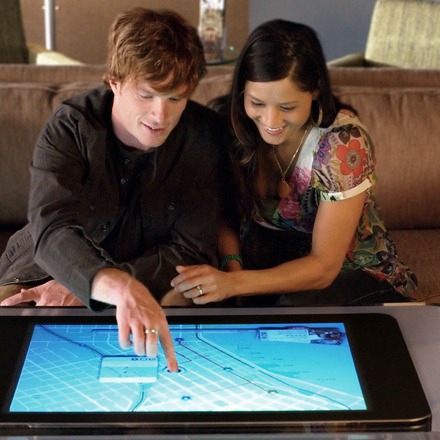The good news: Microsoft is taking multi-touch, camera tracking, and gestural technologies seriously, and they have what looks like a very nice implementation that will be one of the first commercial implementations. The bad news: it’ll cost US$10,000 out of the gate. That high price will mean you’ll see at places like T-Mobile stores and Sheraton hotel lobbies first. But what you need to know: you can build your own version, thanks to available open source tools, with is likely to be more useful for music.
Good sources of commentary:
New Media Initiatives Blog at Walker Arts Center, which notes this could be museum-friendly tech.
Chris O’Shea @ Pixelsumo, who has built a device something like this himself.
The video does show what’s cool about Surface — and it’s easy to imagine these same techniques being applied to live visual and music performance. (People have already tried experiments in that, and I think there’s a lot more to be done — once you’re talking music rather than just digital snapshots, you get into deeper questions about how to model the interface.)
But let’s get a few things out of the way:
1. Enough about Minority Report, already! Minority Report was a terrific movie from an interface design perspective. (Slightly less so from a … well, movie perspective, but that’s another story.) But this has nothing to do with Minority Report‘s free-form, table-free, gestures in 3D space with gloves interface, unless all vaguely futuristic interfaces will now be compared to that movie. Actually, this thing is more practical, unless you want to share gloves with people at the Sheraton. (Ewwww … oh, and incidentally, there’s no logical reason why in the future we need gloves to do tracking.)
How about other comparisons? My apartment looks kinda like Blade Runner. This ATM is exactly like Lost in Space. If I start selling giant rubber costumes with fins, I can be the first to bring commercially-viable Doctor Who monster technology to a mainstream public. Oh, never mind.
2. “First commercial implementation” is sometimes meaningless. Since the dawn of time, pricey, first-to-market versions have often failed. Look at Apple: Lisa? Newton? Even the Mac initially lost out to the Apple II. That’s just one company. Now, there’s the additional reality of readily-available tools allowing people to take concepts like this and do whatever they want, freely experimenting without market restrictions. The commercial implementations may be more successful in that case — but the independent efforts could be sexier.
3. Tables take up space. Part of the reason you’ll be seeing this in hotel lobbies is that the tracking here presumably requires a large physical object in order to work, much like other interactive tables we’ve seen. If you want gestural or multi-touch technologies to be portable, or work with much smaller computer form factors, you need a different design. I’m still intrigued by what cameras may be able to do with enhanced computing resources.
None of this is intended to criticize Microsoft. I’m personally excited this stuff is catching on. I just want to make sure we remain tethered to the larger realities here.
That said, I’ll be eager to try out the demo version in New York in a couple of weeks, which just happens to coincide with a conference of people interested in musical interface design. Heck, maybe we can convince the Microsoft engineers to come over for a few drinks.
DIY Surface Computing
Be Your Own Bjork: If you want to build your own device like this, the reacTable software is available open source. It’s even available as a library for the free tool Processing, which is an ideal environment in which to learn how to code this stuff. reacTable is a little different from Surface, in that reacTable has objects on the surface to manipulate. That rules out some gestures you might make with your hands, but it does add additional tactile feedback, and, hey, playing with blocks is fun. Actual touch might be more difficult, though other computer vision tools that enable tracking are available.
Chris O’Shea (who comments on today’s announcement on his blog Pixelsumo) had also begun an open source software and hardware project using blocks on tables, called Sonic Forms. That project ultimately didn’t take off, but Chris has gone on to write about, speak publicly about, and do other wonderful things, like a table installation with music boxes.
Of course, my significant other doesn’t live in the world of blogs, and says, wisely, “but would you really want to do that?” That’s not a bad question to answer. It’s worth weighing this against other interface possibilities, and, for that matter, balancing the time you spend on the interface with the time you spend on music. More on both those topics soon.
And yes, obviously whoever shoots photos of these things doesn’t really get this concept. Here’s a hot tip to save you US$10,000:squeeze someone you love right now, huddle next to your computer in front of Google Maps, and you, too, can have “collaborative computing.” (Make sure they point meaningfully at the screen and laugh with delight at … the … directions … to the airport.) Since you can do this with a normal laptop, you don’t have to put a giant, clunky digital table in your living room. Which is good, because those coffee table books might screw up the tracking.
